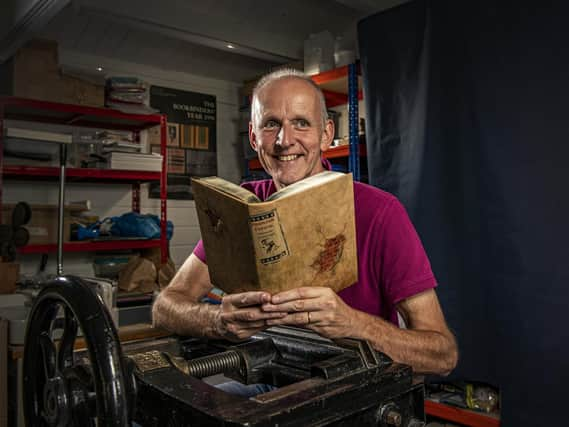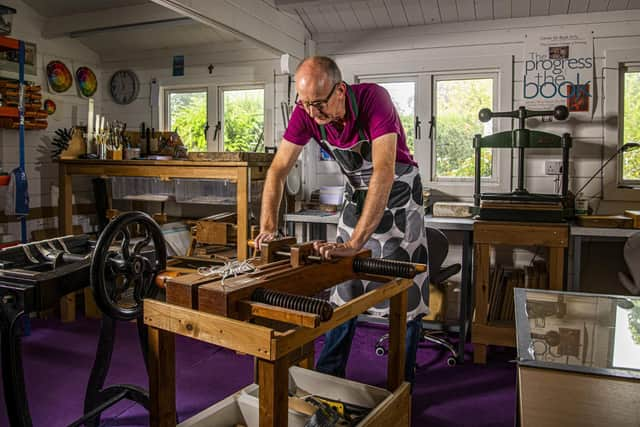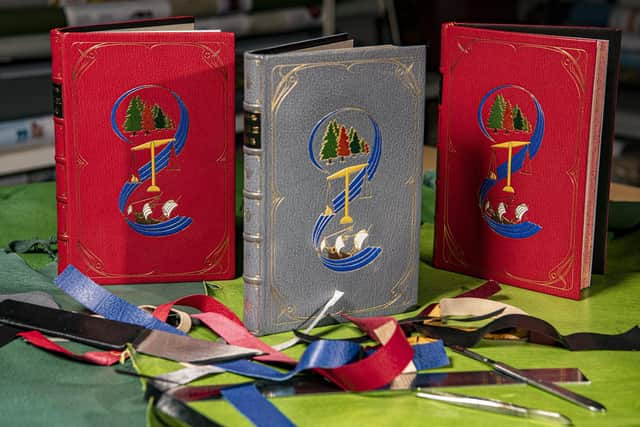Meet the the Hornsea man who quit his job as a management consultant to become a bookbinder


So he did. Being a bookbinder is one of those jobs no one thinks much about, apart from bookbinders who think about it all the time, judging by Glenn, who is filled with voluble enthusiasm. His business is called Signature Bindings and he runs it from the family home in Hornsea, East Yorkshire.
Glenn, 57, has been a professional bookbinder since 2008, his new life starting after he attended a beginners’ course in Norfolk. “I knew straight away that was what I wanted to do. It was a real light-bulb moment,” he says. “It’s just grown from there. I’ve never looked back, to be honest. You never get rich being a bookbinder but it’s just such a satisfying job to do.”
Advertisement
Hide AdAdvertisement
Hide AdBookbinders are a little like surgeons with books for patients. There are different aspects to the job: conservation, restoration and repair. “I don’t do all of those,” Glenn says.


He explains that for conservation, you need to be a qualified conservator, adding that the work involves minimal intervention to make an old book usable again but doing nothing to harm it.
“Restoration is putting something back to exactly as it was when first made, which again I don’t do. Mine is the repair side… putting a new binding on, repairing the existing binding, reattaching a board that’s come off.”
Glenn’s bindery is at the end of the garden in a workshop, a quiet spot with a graveyard beyond. “This is my world, where I spend most of my time,” he says, opening the door.
Advertisement
Hide AdAdvertisement
Hide AdInside all is neat and ordered, although Glenn, as can be the way with tidy people, says it is usually neater than this. On one work table there is a leather-covered edition of Shakespeare’s work in Chinese, ordered by a publisher in Shanghai, a new book rather than a restoration.


Leather tools hang in neat ranks along one wall, and some are heated on an electric stove and used with gold leaf or gold foil.
“The leaf is laid onto the leather but first you paint on essentially egg white, albumen, and that acts as a heat-sensitive glue. When you put the hot tool through the gold leaf, it activates the albumen beneath.”
There are manual presses, including a Victorian nipping press from Hull dating back to the days when printers had their own bookbinding departments.
Advertisement
Hide AdAdvertisement
Hide AdOn the wall there is a framed copy of an engraving showing a printer at work in 1560, which Glenn unhooks and carries over to show how bookbinding has remained much the same since printing began.
“These tools they are using are exactly what I am using. This press here,” he says, pointing to one the other side of the workshop, “is this press here. The thing on the top is called a plough and that runs up and down this groove here. He’s using a sewing frame and I use one of those as well. It’s fascinating how little it has changed.”
He pulls out a piece of bookbinding leather. This is goat skin, commonly used in high-end bookbinding, although calf is employed too. “A skin of that size and quality would be about £100. You can get cheap ones, but it shows.”
Glenn places a piece of leather on an old printers’ litho-stone, showing how he pares down to the required thickness using a razor.
Advertisement
Hide AdAdvertisement
Hide AdAs for his repair work, much of that involves family Bibles. “Hefty Victorian Bibles passed down the generations, and with family history in there. I’ve done a couple of Bibles from the late 1500s and with both of those there was quite a lot of work to do on the pages before you could do anything else.”
Those Bibles had been in the same families for generations. “They’d both got the original bindings, but the bindings were in a poor state. I had to try to retain as much of the original leather binding as I could but they both needed new spines.
“You could get scared about damaging it, but I treat all the books the same way. If you think too much about a book being 400 years old, it can get a bit scary.”
Some of the books that Glenn works on are valuable, perhaps worth £10,000 or more, but many are simply treasured by their owners.
Advertisement
Hide AdAdvertisement
Hide Ad“People love it when they get an old friend back. Often the books are repaired for sentimental value. I do a lot of cookery books or dictionaries, which intrinsically aren’t worth much, and even the big Victorian family Bibles aren’t worth a lot. But for them, to get it back in one piece and they can read it, they love it and it’s great.”
The jobs he takes on tend to vary. One recent customer wanted a blank A4 sketchbook in a leather binding featuring a model of DNA. “He 3D-printed that for me and that was moulded onto the cover. It was stuck on the card, and the leather went on to that,” adds Glenn.
Bookbinding has two societies, the Society of Bookbinders and Designer Bookbinders. Glenn belongs to both and has found his fellow binders to be a supportive bunch. Designer bookbinding is what he enjoys the most, and his covers are works of art in themselves.
He buys high-quality books, gives them a new cover, endpapers and so on, and enters the reborn books into competitions, and has the prizes to show for it. “Everyone has their own style. I’m still developing mine a bit, but I tend to use certain techniques. I use an airbrush in my design work,” he says.
Advertisement
Hide AdAdvertisement
Hide AdGlenn designs these covers for books he picks up at fairs such as the York National Book Fair. Examples include a limited-edition book called The Fort, one of only 80 copies to be published. He took the paper book apart and rebound it in decorated leather to enter a competition. His new cover has a geometric design, with gold leaf sprinkled on goat skin.
Another example is his modified copy of The Pyed Pyper, an illustrated book published by the Old Stile Press, which prints fine books using Letterpress.
“It has a covering in leather, it’s got a leather spine which I’ve decorated,” Glenn says. “I’ve used tools to create the texture on it and embossed it with various features. I created the endpapers and laid a leather line into it.”
The book cost Glenn around £250 and he would hope to sell his copy to collectors for about £1,500. That might sound like a lot, but the work took around 250 hours. “When you work it out in hours, it’s nothing. You don’t get your money back,” he says.
Advertisement
Hide AdAdvertisement
Hide AdAnother example is a Kipling book that he bought in York. “It’s not illustrated but it’s a deluxe edition. It’s paper but it’s called Japanese vellum because it mimics the feel of vellum. There were 100 copies of this printed, signed by Kipling, and this is no 94.”
Glenn has been a Licentiate of Designer Bookbinders for seven years. This is a precursor to becoming a Fellow of Design Bookbinders. “Fellows are binders who have reached the highest level of excellence recognised by their peers, and they number about 30,” he says.
His designer books come in decorated wooden boxes which he makes. “It’s a joy, frankly, and if I didn’t have to pay any bills, I’d be quite happy to do it for nothing.”
For Glenn, his work is anything but a bind.
Glenn teaches a one-day beginners’ workshop in Hull. Find out more at www.glennmalkin.com